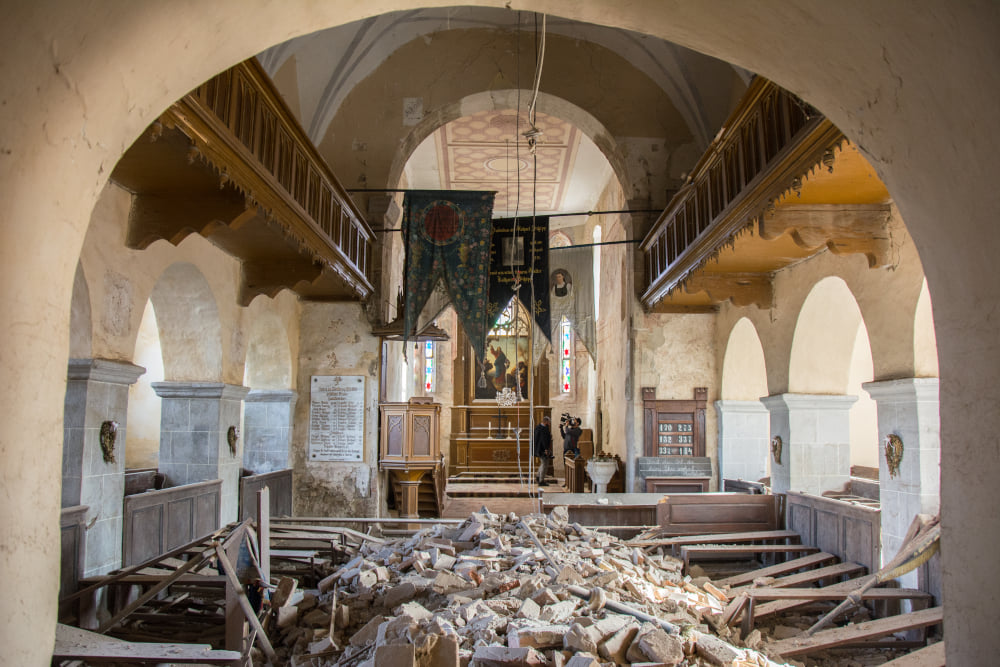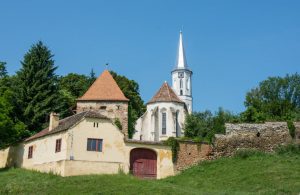
The collapse of the late Gothic vault of the fortified church in Altana on November 4th has opened a Pandora’s box regarding the issues that these heritage buildings are facing across Transylvania.
The landscape of fortified churches in Romania has been recognized as a valuable resource of unique historical and architectural value at a European level, placing Romania on the map as a European destination with rich historic buildings and beautiful landscapes.
At the same time, this cultural heritage is challenging to maintain, being exposed to environmental pressures, natural erosion, lack of clear and sustainable national or local policies addressing cultural heritage preservation and conservation, or furthermore – reuse, witnessing large social and economic changes.
In order to understand why the ceiling has collapsed, we need first to look at the architectural changes that the building has suffered over time, and we will quote here the short analysis made by monument restorer Stefan Vaida, from the Association Monumentum, initiators of the “Ambulanta pentru Monumente” project, which has been awarded the Europa Nostra Award. “The fortified church in Altana has been built around the end of the 13th century, with a flat wooded ceiling. After about 250 years a cross vault was built for purely aesthetic reasons related to the trend of the time. The new Gothic vault is installed in an improvised manner, without any interlocking with the masonry, putting a great deal of horizontal stress on the walls of the church. The walls of the side aisles are not able to take the impact of the forces and they have slightly decreased in the past 500 years. In 1848 the bad experience with the cross-ribbed vault from the choir convinced the parishoners of Altana to abandon it and build a flat ceiling. This solved the problems of the choir. The church of Altana was originally built as a three-nave Romanesque basilica, with a nave that was directly illuminated from the outside. No wonder that such a vault completely collapses when the outer walls move. The causes may be related to the work done on the roof in recent years, by the relief of the roof truss when the tiles were removed, by the load on the vault due to trepidations during the work, or simply that in time the keystones of the vault have sunk so much that they could no longer bear the load.”
Adding on to the damages to the historic fabric of the church, come to the challenges posed by the drastic changes in the fabric of the communities. Beside the exodus of the Saxon ethnic community, the Romanians and other ethnic minorities have also left the villages, especially the younger generations, leaving a tremendous void in terms of local human resources, expert knowledge and financial means to further sustain the cultural heritage sites.
On the other hand, access to and innovation of heritage communities, people who value specific aspects of the cultural heritage of the fortified churches and wish to contribute to their preservation, is limited by the policies adopted at the local and national level and by the lack of vision of the owners. Romania for example is not yet a signator of the Faro Convention which establishes rights and responsibilities to and for cultural heritage.
Against this context, the Fortified Churches Foundation, with the support of the German Government, has initiated a program addressing several fields of preservation of monuments, including the further-use or re-functionalization of the fortified church buildings, aiming to identify uses which integrate the initial function of the building and keep to their historical and architectural value.
The further use or re-use of historic buildings in an attempt to maintain the cultural heritage sites relevant in the new design of contemporary societies is not a new or foreign practice in the context of the fortified churches if we look at how these buildings used to adapt to the needs of the community living around them.
On the other hand, in the past, the preservation and conservations of these buildings were in the duty of the Saxon religious community, but due to the tremendous social and recent economic changes, this responsibility has shifted to the owners and civil society initiatives which need to establish a new relation to the sites and define a new use for them within the community life.
And now it is the time to act in this regard. On an international level, the EU is starting to explicitly promote adaptive reuse of heritage as a practice. In Romania, more and more NGOs are doing a large part of the job of the public institutions, so there is a real change in how the value of cultural heritage is perceived at the civil society level. This change is complemented by the efforts of some public institutions, like the National Heritage Institute who has recently launched the In-Herit initiative – National Centre for Information and Promotion of Cultural Heritage.
And to argue in favour of these changes, we salute the solution for the future proposed by Stefan Vaida:
To reconstruct a new Gothic vault costs a fortune and will always be a weak point of the church in the future. The structural and civil engineers will propose all possible concrete and steel anchors that will damage the church. The most elegant, sustainable, and historically argued solution is to restore the original wooden ceiling and create a new atmosphere in the church. One should not be afraid of changes, even if most of the people from Altana have experienced the church in this way…”
The Fortified Churches Foundation has launched a call for donations in order to restore the fortified church in Altana and you can send your contributions by accessing this link.
Ramona Laczko David
Cultural Advisor, Fortified Churches Foundation





Follow us: